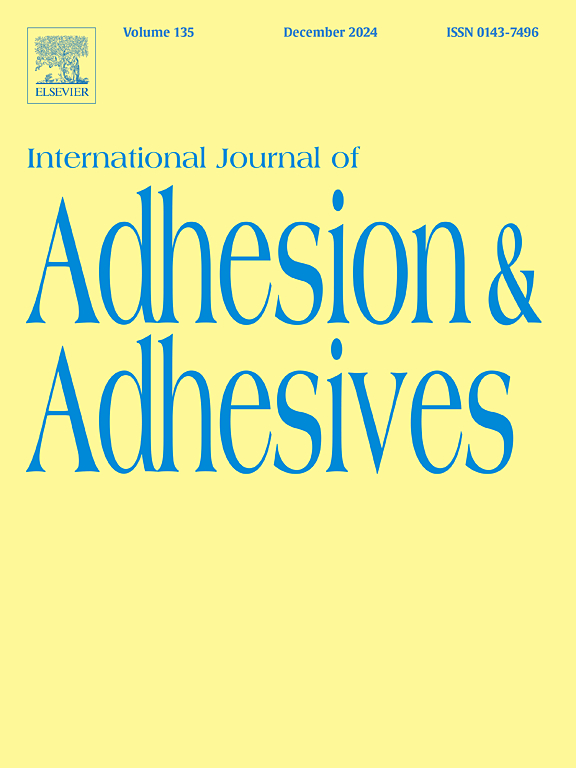含姜黄素的纳米二氧化硅自蚀刻粘接体系的研制与表征
IF 3.2
3区 材料科学
Q2 ENGINEERING, CHEMICAL
International Journal of Adhesion and Adhesives
Pub Date : 2025-06-03
DOI:10.1016/j.ijadhadh.2025.104070
引用次数: 0
摘要
评估将姜黄素锚定在纳米二氧化硅(CAN)上的实验粘合剂(EXP)对弯曲强度、抗菌潜力、细菌胶原酶活性和与牙本质的结合强度(BS)的影响。测试了含有0%、1%、2.5%和5% CAN的商业胶粘剂和exp。在160 M (n = 20)中制备空腔,其中一半为诱导龋。粘接后,用复合材料修复空腔,切片成棒状,37℃保存24小时,6个月,1年后进行BS测试。用扫描电镜分析骨折模式,并评估细菌胶原酶耐药性。exp具有相似的抗弯强度和抗菌活性(p >;0.05),均高于商业(p <;0.05)。在龋病牙本质中,CAN0 %和CAN1 %的BS最低(p <;0.05),而CAN1 %和CAN2.5 %的BS最低(p <;0.05)。在健全牙本质中,can2.5%表现出最低的BS (p <;6个月后0.05),1年后仍保持最低水平。在健康牙本质中,粘连性骨折在24 h后以商用和can2.5%的牙本质为多见,而混合性骨折以can0%和can1%的牙本质为多见。随着年龄的增长,混合性骨折更加频繁。在龋齿影响的牙本质中,黏合剂骨折随着时间的推移而增加。老化导致杂化层退化,在Exps中出现Whitlockite晶体。所有胶粘剂均表现出生物降解。在EXP中加入CAN不仅没有增强抗弯强度,而且也没有增强抗菌潜能或BS。随着时间的推移,高浓度的CAN可能会损害BS。EXP对细菌胶原酶无抑制作用。本文章由计算机程序翻译,如有差异,请以英文原文为准。
Development and characterization of self-etch adhesive system containing curcumin anchored to nanosilica on the bond strength to sound and caries-affected dentin
To evaluate the effects of incorporating curcumin anchored to nanosilica (CAN) into an experimental adhesive (EXP) on flexural strength, antimicrobial potential, bacterial collagenase activity, and bond strength (BS) to dentin. A commercial adhesive and EXPs containing 0 %, 1 %, 2.5 %, and 5 % CAN were tested. Cavities were prepared in 160 M (n = 20), half with induced caries. After adhesive application, cavities were restored with composite, sectioned into sticks, and stored at 37 °C for 24 h, 6 months, and 1 year before BS testing. Fracture patterns were analyzed using scanning electron microscopy, and bacterial collagenase resistance was assessed. EXPs exhibited similar flexural strength and antimicrobial activity (p > 0.05), both higher than commercial (p < 0.05). In caries-affected dentin, CAN0 % and CAN1 % had the lowest BS (p < 0.05) after 24 h, while CAN1 % and CAN2.5 % exhibited the lowest BS (p < 0.05) after 6 months. In sound dentin, CAN2.5 % showed the lowest BS (p < 0.05) after 6 months and remained the lowest after 1 year in both substrates. In sound dentin, adhesive fractures were more common in commercial and CAN2.5 % after 24 h, whereas mixed fractures predominated in CAN0 % and CAN1 %. With aging, mixed fractures became more frequent. In caries-affected dentin, adhesive fractures increased over time. Aging caused hybrid layer degradation, with Whitlockite crystals in Exps. All adhesives showed biodegradation. Incorporating CAN into EXP did not flexural strength but also did not enhance antimicrobial potential or BS. High CAN concentrations may have compromised BS over time. EXP showed no effect against bacterial collagenase.
求助全文
通过发布文献求助,成功后即可免费获取论文全文。
去求助
来源期刊

International Journal of Adhesion and Adhesives
工程技术-材料科学:综合
CiteScore
6.90
自引率
8.80%
发文量
200
审稿时长
8.3 months
期刊介绍:
The International Journal of Adhesion and Adhesives draws together the many aspects of the science and technology of adhesive materials, from fundamental research and development work to industrial applications. Subject areas covered include: interfacial interactions, surface chemistry, methods of testing, accumulation of test data on physical and mechanical properties, environmental effects, new adhesive materials, sealants, design of bonded joints, and manufacturing technology.
 求助内容:
求助内容: 应助结果提醒方式:
应助结果提醒方式:


